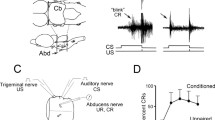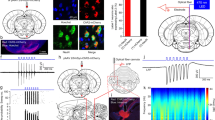Abstract
In the present study we examined the effects of the specific NMDA receptor antagonist CPP on discrimination reversal learning in rabbits. We report two primary findings. First, the institution of NMDA receptor blockade had no effect on a learned discrimination. Second, after stimulus reversal, CPP treatment impaired acquisition of the discrimination reversal. This impairment manifested itself early in training as a retardation in acquisition of a CR to the new CS+ and late in training as an inability to suppress responsiveness to the new CS-. Given the comparability of the present results with previously published results for phenytoin-treated rabbits, we suggest that the effects of phenytoin on learning in this paradigm is at least in part mediated by its effects on NMDA receptors. We further suggest that these findings emphasize the need to better define the role of NMDA receptor activation and hippocampally-mediated circuits in a variety of associative learning paradigms.
Similar content being viewed by others
References
Bahro, M., Schreurs, B. G., Sunderland, T., & Molchan, S. E. (1996). The effects of scopolamine, lorazepam, and glycopyrrolate on classical conditioning of the human eyeblink response.Psychopharmacology, 112, 395–400.
Banks, M. K., Mohr, N. L., Bernard, E. A., Logue, S. F., Steinmetz, J. E., & Garraghty, P. E. (1995). A comparison of the effects of CPP and phenytoin on transfer from appetitive to aversive contexts in adult rats.Society for Neuroscience Abstracts, 21, 204.
Banks, M. K., Mohr, N. L., Besheer, J., Steinmetz, J. E., & Garraghty, P. E. (1999). The effects of phenytoin on instrumental appetitive to aversive transfer in rats.Pharmacology, Biochemistry and Behavior, 63, 465–472.
Bashir, Z. I., Berretta, N., Bortolotto, Z. A., Clark, K., Davies, C. H., Frenguelli, B. G., Harvey, J., Potier, B. & Collingridge, G. L. (1994). NMDA receptors and long-term potentiation in the hippocampus. In G. L. Collingridge, & J. C. Watkins (Eds.),The NMDA receptor, 2nd edition (pp. 294–312). Oxford: Oxford Press.
Berger, T. W., & Orr W. B. (1983). Hippocampectomy selectively disrupts discrimination reversal conditioning of the rabbit nictitating membrane response.Behavioral Brain Research, 8, 49–68.
Berger, T. W., & Thompson, R. F. (1978). Identification of pyramidal cells as the critical elements in hippocampal neuronal plasticity during learning.Proceedings of the National Academy of Sciences (USA) 75, 1572–1576.
Berger, T. W., Alger, B., & Thompson, R. F. (1976). Neuronal substrate of classical conditioning in the hippocampus.Science, 192, 483–485.
Brown, L. M., Lee, Y., & Teyler, T. J. (1994). Antiepileptics inhibit cortical N-methyl-d-aspartate-evoked [3H]norepinephrine efflux.European Journal of Pharmacology, 254, 307–309.
Buller, A. L., Larson, H. C., Schneider, B. E., Beaton, J. A., Morrisett, R. A., & Monaghan, D. T. (1994). The molecular basis of NMDA receptor subtypes: native receptor diversity is predicted by subunit composition.Journal of Neuroscience, 14, 5471–5484.
Chen, G., & Steinmetz, J. E. (2001). Intra-cerebellar infusions of NMDA receptor antagonist AP5 disrupts classical eyeblink conditioning in rabbits.Brain Research, in press.
Churchill, J. D., Voss, S. E., Miller, D. P., Steinmetz, J. E., & Garraghty, P. E. (1998). Phenytoin blocks the reversal of a classically conditioned discriminative eyeblink response in rabbits.Epilepsia, 39, 584–589.
Davies, J., Evans, R. H., Herrling, P. L., Olverman, A. W., Pook, P., & Watkins, J. C. (1986). CPP, a new potent and selective NMDA antagonist. Depression of central neuron responses, affinity for [3H]D-AP5 binding sites on brain membranes and anticonvulsant activity.Brain Research, 382, 169–173.
Esplin, D. W. (1957). Effects of diphenylhydantoin on synaptic transmission in cat spinal cord and stellate ganglion.Journal of Pharmacology and Experimental Therapeutics, 120, 301–323.
Gabriel, M., Kang, E., Poremba, A., Kubota, Y., Allen, M. T., Miller, D. P., & Steinmetz, J. E. (1996). Neural substrates of discriminative avoidance learning and classical eyeblink conditioning in rabbits: a double dissociation.Behavioral Brain Research, 82, 23–30.
Gould, T. J., & Steinmetz, J. E. (1994). Multiple-unit activity from rabbit cerebellar cortex and interpositus nucleus during classical discrimination/reversal eyelid conditioning.Brain Research, 652, 98–106.
Greenberg, D. A., Cooper, E. C., & Carpenter, C. L. (1984). Phenytoin interacts with calcium channels in brain membranes.Annals of Neurology, 16, 616–617.
Harris, E. W., Ganong, A. H., Monaghan, D. T., Watkins, J. C., & Cotman, C. W. (1986). Actions of 3-((+/-)-2-carboxypiperazin-4-yl)propyl-1-phosphonic acid (CPP), a new highly potent antagonist of N-methyl-D-aspartate receptors in the hippocampus.Brain Research, 389, 174–177.
Harvey, J. A., Gormezano, I., & Cool-Hauser, V. A. (1983). Effects of scopolamine and methylscopolamine on classical conditioning of the rabbit nictitating membrane response.Journal of Pharmacology and Experimental Therapeutics, 225, 42–49.
Leung, L. S., & Shen, B. (1993). Long-term potention in hippocampal CA1: effects of afterdischarges, NMDA antagonists, and anticonvulsants.Experimental Neurology, 119, 205–214.
Lincoln, J. S., McCormick, D. A., & Thompson, R. F. (1982). Ipsilateral cerebellar lesions prevent learning of the classically conditioned nictitating membrane/eyelid response.Brain Research, 242, 190–193.
McCormick, D. A., & Thompson, R. F. (1984). Cerebellum: Essential involvement in the classically conditioned eyelid response.Science, 223, 296–299.
McCormick, D. A., Clark, G. A., Lavond, D. G., & Thompson, R. F. (1982). Initial localization of the memory trace for a basic form of learning.Proceedings of the National Academy of Sciences (USA), 3, 293–299.
Merritt, H. H., & Putnam, T. J. (1938). Sodium diphenyl hydantoinate in treatment of convulsive disorders.Journal of the American Medical Association, 111, 1068–1073.
Miller, D. P., & Steinmetz, J. E. (1997) Hippocampal activity during classical discrimination-reversal eyeblink conditioning in rabbits.Behavioral Neuroscience, 111, 70–79.
Monaghan, D. T., & Buller, A. L. (1994). Anatomical, pharmacological, and molecular diversity of native NMDA receptor subtypes. In G. L. Collingridge, & J. C. Watkins (Eds.),The NMDA receptor, 2 nd edition (pp. 158–176) Oxford: Oxford Press.
Moore, J. W., Goodell, N. A. & Solomon, P. R. (1976). Central cholinergic blockage by scopolamine and habituation, classical conditioning, and latent inhibition of rabbit’s nictitating membrane response.Physiological Psychology, 4, 395–399.
Morris, R. G. M., & Davis, M. (1994). The role of NMDA receptors in learning and memory. In G. L. Collingridge, & J. C. Watkins (Eds.),The NMDA receptor, 2 nd edition (pp. 340–375). Oxford: Oxford Press.
Robinson, G. B. (1993). MK801 retards acquisition of a classically conditioned response without affecting conditioning-related alterations in perforant path-granule cell synaptic transmission.Psychobiology, 21, 253–264.
Schugens, M. M., Egerter, R., Daum, I., Schepelmann, K., Klockgether, T., & Löschmann, P.-A. (1997). The NMDA antagonist memantine impairs classical eyeblink conditioning in humans.Neuroscience Letters, 224, 57–60.
Servatius, R. J., & Shors, T. J. (1996). Early acquisition, but not retention, of the classically conditioned eyeblink response is N-methyl-d-aspartate (NMDA) receptor dependent.Behavioral Neuroscience, 110, 1040–1048.
Solomon, P. R., Groccia-Ellison, M., Flynn, D., Mirak, J., Edwards, K. R., Dunehew, A., & Stanton, M. E. (1993). Disruption of human eyeblink conditioning after central cholinergic blockade with scopolamine.Behavioral Neuroscience, 107, 271–279.
Solomon, P. R., Solomon, S. D., Vander Schaaf, E., & Perry, H. E. (1983). Altered activity in the hippocampus is more detrimental to classical conditioning than removing the structure.Science, 220, 329–331.
Steinmetz, J. S., Logue, S. F., & Steinmetz, S. S. (1992). Rabbit classically conditioned eyelid responses do not reappear after interpositus nucleus lesions and extensive post-lesion training.Behavioral Brain Research, 51, 103–114.
Thompson, L. T., Moyer, J. R., Akase, E., & Disterhoft, J. F. (1994). A system for quantative analysis of associative learning. Part 1. Hardware interfaces with cross-species applications.Journal of Neuroscience Methods, 54, 109–117.
Wamil, A. W., & McLean, M. J. (1993). Phenytoin blocks N-methyl-d-aspartate responses of mouse central neurons.Journal of Pharmacology and Experimental Therapeutics, 267, 218–227.
Wilder, B. J., McLean, J. R., & Uthman, B. M. (1993). Phenytoin. In E. Wyllie (Ed.),The Treatment of epilepsy: Principles and practices (pp. 887–899). Philadelphia: Lea & Febiger.
Woodbury, D. M. (1982). Phenytoin: Mechanisms of action. In D. M. Woodbury, J. K. Penry, & C. E. Pippenger (Eds.),Antiepileptic drugs (pp. 269–281) New York: Raven Press.
Yaari, Y., Selzer, M. E., & Pincus, J. H. (1986). Phenytoin: Mechanisms of its anticonvulsant action.Annals of Neurology, 20, 171–184.
Author information
Authors and Affiliations
Corresponding author
Rights and permissions
About this article
Cite this article
Churchill, J.D., Green, J.T., Voss, S.E. et al. Discrimination reversal conditioning of an eyeblink response is impaired by NMDA receptor blockade. Integr. psych. behav. 36, 62–74 (2001). https://doi.org/10.1007/BF02733947
Issue Date:
DOI: https://doi.org/10.1007/BF02733947




